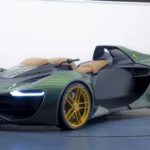Xiaomi, the Chinese tech giant renowned for its smartphones, has stepped into the electric vehicle arena with the grand reveal of its first-ever electric car, the Xiaomi SU7. The company, once synonymous with affordable smartphones, is now set to disrupt the electric car market, claiming that its SU7 can outperform Porsche and boasts more technology than Tesla. The announcement came at a highly anticipated event in Beijing, where Xiaomi showcased its latest creation to the world.
The Xiaomi SU7 pronounced “soo-chee” in Chinese, is a sedan built on the company’s proprietary Modena Architecture, featuring cutting-edge HyperEngine electric motors with an astonishing 21,000rpm capability. Xiaomi has also emphasized its die-casting machines, delivering a clamping force of 9,100 tons, surpassing Tesla’s manufacturing capabilities. The lineup includes the dual-motor all-wheel-drive SU7 Max and the single-motor rear-wheel-drive SU7.

While the pricing details are yet to be unveiled, Xiaomi is already making bold claims about the SU7 Max’s capabilities. The company boasts an impressive range of up to 800km (497 miles) according to the China Light-Duty Vehicle Test Cycle (CLTC) and an acceleration of just 2.78 seconds for 0-100km/h, surpassing both Tesla’s Model S and Porsche’s Taycan Turbo. Xiaomi attributes these achievements to the collaboration with battery maker CATL, utilizing a generous 101kWh 800V high-voltage platform.

Xiaomi’s foray into the electric vehicle market is backed by a team of industry veterans, including Tianyuan Li from BMW’s iX series and iVision concepts, James Qiu from Mercedes-Benz’s Vision EQXX design, and renowned BMW veteran Chris Bangle as a design consultant. The SU7, comparable in size to the BMW 5 series, offers three color options: “aqua blue,” gray, or olive green. Xiaomi’s CEO, Lei Jun, highlighted the spacious legroom and trunk spaces of 517L in the back and 105L in the front during the launch event.

Xiaomi’s commitment to innovation is evident in the SU7’s features. The vehicle comes equipped with the HyperOS in-car entertainment system powered by Qualcomm’s Snapdragon 8295 processor, boasting a quick 1.49-second boot time. The 16.1-inch 3K central screen supports multitasking with up to three split windows, and the entertainment experience is enhanced by 23 internal Dolby Atmos speakers.
| Feature | Specification |
|---|---|
| Model | Xiaomi SU7 (SU7 Max) |
| Body Style | Sedan |
| Platform | Modena Architecture |
| Motor(s) | Single-motor RWD (Dual-motor AWD for SU7 Max) |
| Horsepower | 295hp (495hp for SU7 Max) |
| Torque | N/A |
| 0-100 km/h Acceleration | 5.3 seconds (2.78 seconds for SU7 Max) |
| Range (CLTC) | 517 km (800 km for SU7 Max) |
| Battery Capacity | 73.6 kWh (101 kWh for SU7 Max) |
| Charging | N/A |
| Top Speed | 265 kmph (165 mph) |
| Dimensions | L: 4950mm, W: 1900mm, H: 1500mm (Estimated) |
| Curb Weight | N/A |
| Wheelbase | N/A |
| Seating Capacity | 5 |
| Cargo Capacity | 517L rear / 105L front |
| Infotainment System | HyperOS with 16.1-inch 3K central display |
| Processor | Qualcomm Snapdragon 8295 |
| Audio System | 23 Dolby Atmos speakers |
| Autonomous Driving | Xiaomi Pilot platform with NVIDIA Drive Orin processors and Lidar |
| Other Features | Smart booster car seat, wireless CarPlay and AirPlay, physical buttons for climate control, spoiler, and body height adjustment |
Moreover, Xiaomi plans to open up its CarIOT ecosystem to third parties, introducing features like a smart booster car seat that reminds users to fasten their seat belts. Notably, even iPhone users can leverage Xiaomi’s car features with support for wireless CarPlay and AirPlay connectivity.

Recognizing the preference for physical buttons, Xiaomi has retained some for climate control, spoiler toggling, and body height adjustment. The SU7 also boasts autonomous driving capabilities through its Xiaomi Pilot platform, powered by up to two NVIDIA Drive Orin processors and a variety of sensors, including a top-mounted Lidar with a visual range of up to 200m.
Xiaomi aims to complete autonomous driving tests in 100 Chinese cities by the end of 2024. Additionally, the company teased future updates, including the HyperEngine V8s with a record-breaking 27,200rpm, set to be incorporated into cars by 2025








